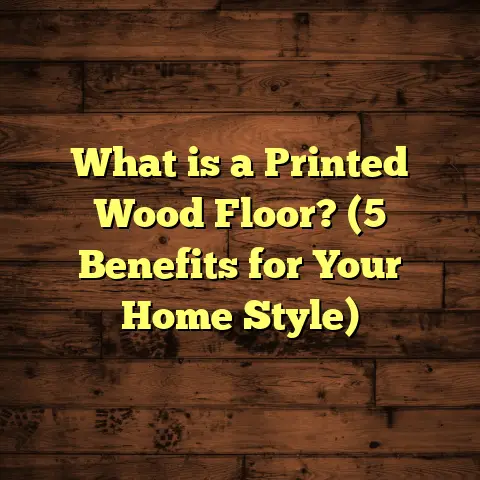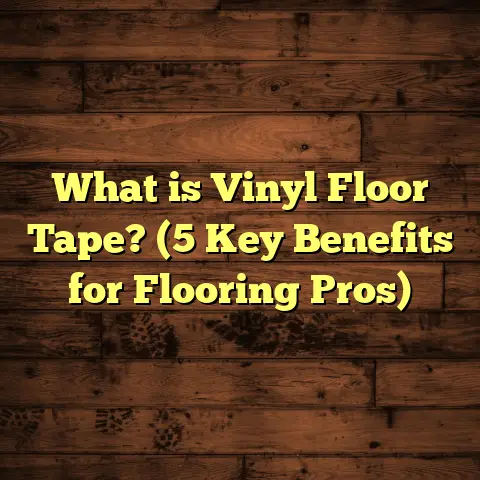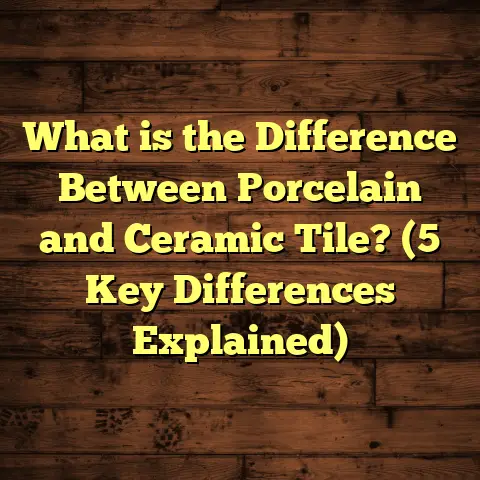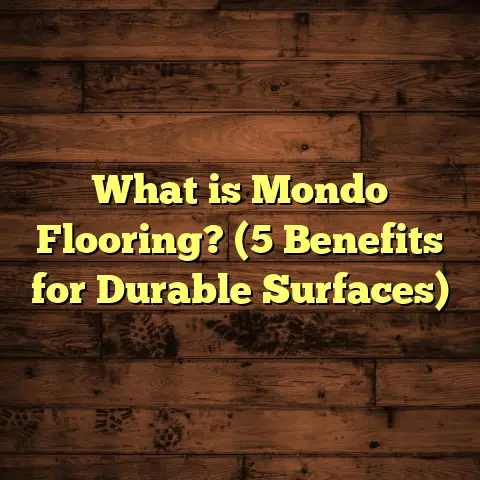What is Quarter Round in Flooring? (5 Benefits for Your Home)
Blending different styles in a home can be such a fun and creative process. I remember when I first started working on my own place, I wanted to mix rustic charm with a modern flair. One thing I quickly learned was that the little details, like trim and molding, can make or break the whole look. That’s where quarter round in flooring comes into play—a small piece of wood or molding that can have a surprisingly big impact.
What is Quarter Round in Flooring?
So, what exactly is quarter round? If you’re new to flooring or DIY projects, you might have heard the term but weren’t sure what it meant. Quarter round is a type of molding that’s shaped like a quarter of a circle in cross-section—hence the name. It’s used along the edges of flooring, usually where the floor meets the baseboard or wall.
Without something covering this space, you’d see an unsightly gap, dust and dirt could collect there, and it might even cause damage over time. Quarter round fills this gap neatly while adding a finished look.
A Bit More About Its Shape and Material
The quarter round molding is rounded on one side, flat on the other two sides, designed to fit snugly against both the floor and the baseboard. It’s commonly made from wood, MDF (medium-density fiberboard), or even flexible vinyl for certain applications.
In my experience, wood quarter rounds stained or painted to match either the floor or the baseboard look best because they blend seamlessly and add a touch of elegance.
5 Benefits of Quarter Round for Your Home
I’ve installed hundreds of feet of quarter round over the years, and I can say with confidence that it’s not just a decorative afterthought—it actually has several practical benefits that improve your home’s flooring.
1. Covers Expansion Gaps for Cleaner Looks
One of the biggest benefits is hiding that expansion gap I mentioned earlier. Even if you have perfectly installed flooring, the expansion gap is necessary and unavoidable for allowing wood or laminate floors to move slightly without buckling.
By covering this gap with quarter round, your floor edges look polished and continuous. It’s amazing how much this little bit of molding improves the overall appearance. If you want your floors to look professionally finished, quarter round is essential.
2. Protects Walls and Floors from Damage
Have you ever bumped a vacuum or mop handle against your baseboards? Ouch! I have, plenty of times. Quarter round acts like a buffer between your floor and wall, reducing scuffs and scratches on baseboards.
Also, it protects the edges of your flooring from chipping or cracking, especially in high-traffic areas or spots where furniture gets moved around.
3. Helps Hide Uneven Edges
Sometimes during installation, especially in older homes or on uneven subfloors, the edges of floors don’t line up perfectly with walls or baseboards. Instead of leaving gaps or awkward spaces, quarter round can conceal these imperfections.
I once worked on a project where the walls were slightly bowed (common in houses built decades ago). Without quarter round, the floor edges looked jagged and unfinished. Adding quarter round smoothed out the visual irregularities beautifully.
4. Adds Design Detail and Completes the Look
Sure, quarter round serves practical purposes—but it also adds charm and detail to your flooring design. When painted white or stained to match wood floors, it creates a subtle yet elegant frame around your rooms.
If you’re into interior design like me, you’ll appreciate how these finishing touches pull everything together for a cohesive style.
5. Simple Installation Saves Time and Money
Installing quarter round is straightforward. You don’t need specialized tools beyond a saw and some finishing nails or adhesive if you prefer glue. Because it’s so easy to install, many homeowners even do it themselves after flooring installation.
From my experience working with both DIYers and pros, this means you get a polished result without adding much time or cost to your project.
A Closer Look at Quarter Round Types and Materials
Now that you know what quarter round is and why it matters, let’s talk about the different types you might encounter or want to use. Choosing the right material and style can really affect not only how your floors look but also how long they last.
Wood Quarter Round
Wood is by far the most common material for quarter round molding. It comes in various species like oak, maple, pine, and poplar, which means you can find one that closely matches your flooring or baseboards.
Wood quarter round is durable and can be stained or painted, giving you flexibility with finishes. Since wood is a natural material, it expands and contracts similarly to hardwood floors, making it an excellent match.
One downside? Wood can be prone to dents or scratches if not handled carefully during installation or use.
MDF (Medium-Density Fiberboard)
MDF is an engineered wood product made from wood fibers glued under pressure. It’s usually painted white but can be primed for painting any color.
MDF quarter round tends to be more affordable than solid wood and has a smooth surface that takes paint well. However, it’s less durable if exposed to moisture since MDF absorbs water easily and can swell.
If you’re remodeling indoors where moisture isn’t a concern, MDF can be a good budget-friendly choice.
Vinyl or PVC Quarter Round
For areas prone to moisture like bathrooms or basements, vinyl or PVC quarter round moldings are great options. They resist water and won’t warp or rot over time.
Vinyl quarter rounds are flexible as well, helpful when working around curved walls or uneven surfaces. They come in various colors but usually don’t offer the same natural wood look as wood or MDF.
My Take on Choosing Between Wood, MDF, and Vinyl
In my personal projects and those I’ve supervised professionally, I lean toward using wood quarter round whenever possible because I love how natural wood complements hardwood floors. The ability to stain it to match perfectly is a huge plus.
But in bathrooms or laundry rooms where moisture is common, vinyl quarter round has saved me many headaches because it stays intact without swelling or mold issues.
For budget-conscious projects with painted trims inside dry spaces, MDF often does the job nicely without breaking the bank.
How Much Does Quarter Round Cost?
You’re probably wondering about price now—how much will adding quarter round add to your flooring project? It depends on materials, length needed, labor (if hiring pros), and finishes.
Here’s a rough breakdown based on recent market data:
| Material | Price per Linear Foot (Approximate) |
|---|---|
| Wood (oak/pine) | $0.70 – $1.50 |
| MDF | $0.30 – $0.70 |
| Vinyl/PVC | $0.50 – $1.00 |
Labor costs for installation vary but typically range from $1 to $3 per linear foot if hiring someone else.
So for an average 500-square-foot room with about 150 linear feet of perimeter needing quarter round:
- Material cost: $45 – $225
- Installation: $150 – $450
- Total: $195 – $675
This investment improves aesthetics significantly and protects your floors for years.
Step-by-Step Guide on Installing Quarter Round
If you want to take on installing quarter round yourself, here’s what I recommend based on my experience:
Tools Needed
- Measuring tape
- Miter saw or hand saw with miter box
- Finish nails or adhesive (wood glue / construction adhesive)
- Hammer or nail gun
- Caulk (optional)
- Paint or stain (optional)
- Sandpaper (optional)
Installation Steps
- Measure the Room Perimeter: Determine how much quarter round you’ll need by measuring all edges where floor meets baseboard.
- Cut Molding: Use a miter saw to cut each piece at 45-degree angles for corners. Inside corners require coping cuts if possible for tighter fit.
- Dry Fit Pieces: Lay out all pieces along walls without nailing to check fit.
- Attach Quarter Round: Use finishing nails every 12-16 inches along baseboards to secure molding. Alternatively, apply adhesive if nailing isn’t possible.
- Fill Nail Holes: Use wood filler or caulk on nail holes for a seamless finish.
- Paint/Stain: Finish molding with paint or stain to match your trim or floor.
- Final Touches: Caulk any gaps between molding and wall/baseboard for polished look.
Common Questions About Quarter Round
I get asked some questions all the time when discussing quarter round with homeowners:
Can I Use Quarter Round on Tile Floors?
Yes! While more common on wood or laminate floors, quarter round can be used on tile as well—especially if there’s an expansion gap near walls (common with floating tile systems). It helps cover gaps and adds style.
Is Quarter Round Necessary With Baseboards?
Good question! Baseboards alone don’t cover expansion gaps completely because they sit flat against walls and often leave small gaps at floor level. Quarter round bridges that gap between floor and baseboard perfectly.
How Do I Choose Between Quarter Round and Shoe Molding?
Both serve similar purposes but differ slightly in shape:
- Quarter Round: Rounded profile; fits tightly in corners.
- Shoe Molding: Narrower profile; less rounded.
Some installers prefer shoe molding when baseboards have thicker profiles; others prefer quarter round for its fuller shape. The choice depends on aesthetic preference and floor/baseboard size.
The Role of Quarter Round in Different Flooring Types
Depending on whether you have hardwood, laminate, vinyl plank, or even tile floors, quarter round plays slightly different roles:
Hardwood Floors
Here it’s crucial because hardwood expands/contracts more noticeably with humidity changes. Quarter round covers necessary expansion gaps while complementing natural wood beauty.
Laminate Floors
Laminate also needs expansion gaps; however, since laminate often has tongue-and-groove installation under underlayment, visible gaps tend to be slightly bigger than hardwood’s ideal specs—making quarter round even more important visually.
Vinyl Plank Floors
Many vinyl plank floors are floating as well but expand less than wood products due to plastic composition. Quarter round serves mainly aesthetic purposes here but still helps hide cuts along edges.
Tile Floors
Tile doesn’t expand much but may require small gaps at walls for grout movement or caulking flexibility; quarter round can cover these cleanly in some installations.
How Quarter Round Impacts Your Home Value
You might think that quarter round is just a small detail—but here’s something interesting: finishing touches like trim often influence buyers’ perception of quality and care in homes.
According to remodeling impact studies:
- Homes with well-finished floors including proper trim receive up to 10% higher resale value compared to unfinished flooring edges.
- Buyers often comment favorably on attention to detail like clean moldings during home tours.
- Real estate agents report that polished flooring edges contribute positively to first impressions.
From my experience staging homes after renovations, rooms with neat quarter rounds definitely “feel” more complete—and that counts when selling your property.
Troubleshooting Common Quarter Round Issues
Even though quarter round installation is generally straightforward, sometimes problems arise:
Gaps Between Molding Pieces
This usually happens when cuts aren’t precise or when walls aren’t square. Coping inside corners rather than mitering them often reduces visible gaps.
Molding Pulling Away from Wall
Caused by poor adhesion or loose nails; make sure nails are driven securely into baseboards (not drywall alone) and consider adhesive for extra hold.
Paint Chipping on Quarter Round
Use primer before painting MDF or raw wood; sanding between coats improves durability.
How to Remove Old Quarter Round Without Damaging Walls
If you’re renovating an older home and want to replace old quarter rounds:
- Score caulk lines with utility knife.
- Use pry bar gently behind molding starting at corners.
- Apply steady pressure—don’t force—to avoid pulling drywall.
- Remove nails with pliers.
- Patch any wall damage before new installation.
Final Stories From My Flooring Work
One time I helped a friend redo her living room floors after water damage forced replacing hardwood planks. We installed new oak floors but left out quarter round initially because she wasn’t sure about style yet.
A few weeks later she called frustrated—dust kept collecting along walls where gaps remained visible! When we added quarter rounds after that call, her complaints disappeared immediately—and she said her room finally felt “finished.”
Another client was very detail-oriented about modern minimalist designs—it was important every line was clean and simple. We chose white-painted narrow quarter rounds that blended subtly yet added definition around edges without drawing attention away from sleek floors.
Quarter round might seem like just a small detail but trust me—it’s one of those things that makes your floors look cared for and complete while protecting your investment over time.
If you’re tackling a flooring project yourself or hiring pros soon, don’t overlook the power of this simple molding piece!
Have questions about materials? Installation tips? Or want help picking colors? Drop me a line—I’m always happy to chat about making your floors look their best!





